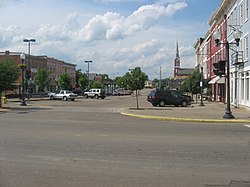Portsmouth, Ohio
| Portsmouth, Ohio | |
|---|---|
| City | |

A view of Market Street Plaza in Historic Boneyfiddle
|
|
| Nickname(s): P-Town | |
| Motto: "Where Southern Hospitality Begins" | |
 Location in the state of Ohio |
|
 Location of Portsmouth in Scioto County |
|
| Coordinates: 38°44′35″N 82°57′56″W / 38.74306°N 82.96556°WCoordinates: 38°44′35″N 82°57′56″W / 38.74306°N 82.96556°W | |
| Country | United States |
| State | Ohio |
| County | Scioto |
| Founded | 1803 |
| Incorporated | 1815 |
| Government | |
| • City Manager | Derek K. Allen, ICMA-CM |
| Area | |
| • Total | 11.07 sq mi (28.67 km2) |
| • Land | 10.73 sq mi (27.79 km2) |
| • Water | 0.34 sq mi (0.88 km2) |
| Elevation | 533 ft (162 m) |
| Population (2010) | |
| • Total | 20,226 |
| • Estimate (2012) | 20,302 |
| • Density | 1,885.0/sq mi (727.8/km2) |
| Time zone | EST (UTC-5) |
| • Summer (DST) | EDT (UTC-4) |
| ZIP codes | 45662-45663 |
| Area code(s) | 740 |
| FIPS code | 39-64304 |
| GNIS feature ID | 1061567 |
| Website | portsmouthoh |
Portsmouth is a city in and the county seat of Scioto County, Ohio, United States. It lies in far southern Ohio, just east of the mouth of the Scioto River at the Ohio River, and across from Kentucky. The population was 20,226 at the 2010 census.
According to historian Charles Augustus Hanna, a Shawnee village was founded at the site of modern-day Portsmouth in late 1758, following the destruction of Lower Shawneetown by floods.
Portsmouth's European-American roots date to the 1790s, when the small town of Alexandria was founded west of Portsmouth's site. Alexandria was flooded numerous times by the Ohio and the Scioto rivers, especially in a massive flood in January and February 1937.
In 1803, Henry Massie spotted a place to move the town away from the flood plains. He began to plot the new city by mapping the streets and distributing the land. Portsmouth was founded in 1803 and was established as a city in 1815. Alexandria soon disappeared.
Portsmouth quickly grew around an industrial base due to its location at the confluence of the Ohio and Scioto rivers; early industrial growth included having meat packing and shipping facilities for Thomas Worthington's Chillicothe farm, located north of Portsmouth on the Scioto River. Portsmouth growth continued with the completion of the Ohio and Erie Canal, which provided access to the Great Lakes, opening up northern markets. The construction of the N&W railyards and the B&O junction at the city also stimulated growth, with railroads soon carrying more freight than the canal. By the end of the 19th century, Portsmouth became one of the most important cities on the Ohio River between Pittsburgh and Cincinnati.
By 1916, Portsmouth was listed as being a major industrial and jobbing center, with it being the fourth-largest shoe manufacturing center in the country and the largest manufacturer of fire and paving bricks in the United States. Wheeling-Pittsburgh Steel (later called Empire-Detroit Steel) employed over one thousand people. There were 100 other manufacturing companies producing goods from furniture to engines.
...
Wikipedia
